
Using 137Cs Resampling Method to Estimate Mean Soil Erosion Rates for Selected Time Windows
Springer International Publishing (Verlag)
978-3-031-52806-4 (ISBN)
This book provides guidelines for using a new approach of resampling the Cs-137 radionuclide tracer which is used to estimate soil erosion rates. The Cs-137 resampling approach will improve significantly the use of the Cs-137 method for assessment of soil erosion, because resampling the radionuclide repeatedly (at least two times, but more sampling campaigns are possible) allows to avoid several methodological difficulties associated with Cs-137 method, namely the problems with small-scale spatial heterogeneity, the question of representativeness of reference site, reference samples, and inappropriate time extent of evaluated period. All these methodological problems are very important for reliability and accuracy of erosion rates estimated by Cs-137 method. If using single sampling approach, the small-scale spatial heterogeneity can be overcome by high number of sampling points, but this is time and labour demanding solution increasing the expenses of the erosion research. The representativeness of reference site is evaluated usually on the basis of expert judgement and knowledge of land use history of studied area, but this approach is often uncertain because the expert judgement can be subjective and the data on land use history is often not sufficient. Further, in many areas an appropriate reference site is not available, what limits the territorial extent of using Cs-137 method. The resampling approach offers its second sampling to be done in a proximate vicinity of the same points sampled during the first sampling campaign. A great advantage is the possibility to decide how long time windows should be investigated. Choosing the time schedule of first and second sampling allows to shorten the time window and adjust it to the study objectives. This is a great improvement of the Cs-137 method, because the time period since the Cs-137 fallout is still growing and thus if using the single sampling approach the results refer to still longer and longer time window(since the Cs-137 fallout until the sampling time), and this period (recently ca 60 years assuming the maximum Cs-137 fallout in 1963) is too long to represent stable land use, because land uses are changing over the time and having the same land use over six decades is rather rare. The improvement of Cs-137 method achieved by resampling approach is significantly contributing to understanding the erosion dynamics and estimating its rates under changing environmental conditions (such as land uses, weather), and it will bring a significant benefit to soil conservation programmes, because Cs-137 method is indispensable for assessing the medium and long term soil erosion rates, and this information is among the basic inputs needed for planning and designing soil conservation measures.
Paolo Porto is currently Associate Professor in Agricultural Hydraulics and Torrent control, at the University Mediterranea of Reggio Calabria (Italy), and Professor in the field of Physical Geography and Geomorphology at the Kazimierz Wielki University of Bydgoszcz (Poland). He obtained in 1989 his Master degree in Forest Sciences at the University Mediterranea, and he completed his PhD in 1995 in Catchment hydrology and torrent control at the University of Bari (Italy). His research activity was developed with the support of several fellowships spent at the Dept of Civil Engineering of the Colorado State University, USA (6 months), at the Department of Engineering and Agro-Forest Technologies of the University of Palermo, Italy (2 years), at the National Research Council of Cosenza, Italy (4 years), and at the Dept of Geography of the University of Exeter, UK (3 years) where he was appointed as 'Honorary Member' from February 2014 to January 2017. His research activity (Scopus H-index=28) in soil erosion, radionuclides, hydrology, and torrent control is well documented in over 100 papers published in international and national journals. Paolo Porto covers also the role of President (2021-2025) of the International Commission on Continental Erosion (IAHS/ICCE), and Vice-President (2022-2025) of the International Association of Sediment and Water Sciences (IASWS).
1. Introduction.- 2. Geographical overview of 137Cs resampling studies.- 3. Validating Cs-137 re-sampling approach by comparing with conventional erosion plot measurements: An example of cultivated site in Italy.- 4. A step-by-step protocol to apply the 137Cs resampling approach to assess soil erosion during chosen time periods
| Erscheinungsdatum | 14.05.2024 |
|---|---|
| Reihe/Serie | Environmental Science and Engineering |
| Zusatzinfo | IX, 137 p. 65 illus., 34 illus. in color. |
| Verlagsort | Cham |
| Sprache | englisch |
| Maße | 155 x 235 mm |
| Themenwelt | Sachbuch/Ratgeber ► Natur / Technik ► Natur / Ökologie |
| Technik ► Umwelttechnik / Biotechnologie | |
| Weitere Fachgebiete ► Land- / Forstwirtschaft / Fischerei | |
| Schlagworte | 137Cs • caesium-137 • Cs-137 • Cs-137 method • erosion tracer • fallout radionuclides • FRN • radionuclide tracer • sediment yield • Soil conservation • Soil erosion • soil erosion rates |
| ISBN-10 | 3-031-52806-9 / 3031528069 |
| ISBN-13 | 978-3-031-52806-4 / 9783031528064 |
| Zustand | Neuware |
| Haben Sie eine Frage zum Produkt? |
aus dem Bereich


